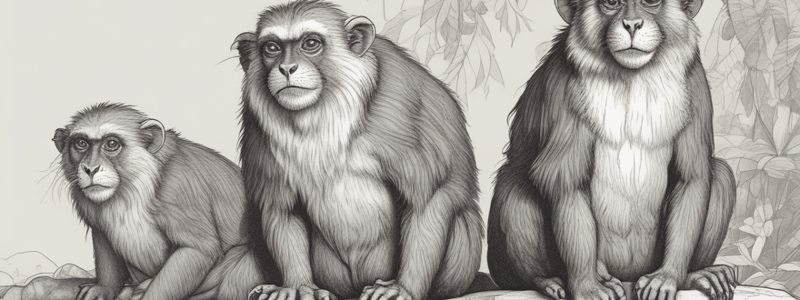Podcast
Questions and Answers
What does the study's methodological approach emphasize in terms of rewards and actions visibility?
What does the study's methodological approach emphasize in terms of rewards and actions visibility?
Visibility of rewards and actions to both participants
What are the possible drivers of cooperative behavior in tamarins according to the study results?
What are the possible drivers of cooperative behavior in tamarins according to the study results?
Intrinsic social tendencies and extrinsic motivational factors
What does the study encourage regarding the cognitive abilities of other species?
What does the study encourage regarding the cognitive abilities of other species?
Re-evaluation, particularly in cooperative contexts
What behavior in capuchin monkeys is being investigated in the study?
What behavior in capuchin monkeys is being investigated in the study?
What is the purpose of exploring the evolutionary origins of aversion to inequity in capuchin monkeys?
What is the purpose of exploring the evolutionary origins of aversion to inequity in capuchin monkeys?
What aspect of capuchins' responses is being tested in comparison to humans?
What aspect of capuchins' responses is being tested in comparison to humans?
What is the main aim of the study mentioned in the text?
What is the main aim of the study mentioned in the text?
What are some activities where cooperation among animals is generally observed?
What are some activities where cooperation among animals is generally observed?
What are some theorized drivers of the evolution of cooperative behavior?
What are some theorized drivers of the evolution of cooperative behavior?
What aspect of tamarins' social system might explain their higher efficiency in cooperative tasks compared to other primates?
What aspect of tamarins' social system might explain their higher efficiency in cooperative tasks compared to other primates?
How many pairs of cottontop tamarins were used as subjects in the study?
How many pairs of cottontop tamarins were used as subjects in the study?
What type of apparatus was used to test cooperation in the study?
What type of apparatus was used to test cooperation in the study?
According to the study, which cognitive ability challenges the notion that only great apes possess it in understanding cooperative tasks?
According to the study, which cognitive ability challenges the notion that only great apes possess it in understanding cooperative tasks?
What design aspect of the experiment likely contributed to the successful cooperation observed in the study?
What design aspect of the experiment likely contributed to the successful cooperation observed in the study?
How were the tamarins trained to manipulate the apparatus in the study?
How were the tamarins trained to manipulate the apparatus in the study?
What does the research emphasize as crucial for encouraging and sustaining cooperative behavior in tasks?
What does the research emphasize as crucial for encouraging and sustaining cooperative behavior in tasks?
According to the critical analysis, what factors are highlighted as crucial for enhancing cooperative behavior in tamarins?
According to the critical analysis, what factors are highlighted as crucial for enhancing cooperative behavior in tamarins?
What does the high success and efficiency rates observed in the study suggest about tamarins' understanding of cooperation and partnership roles?
What does the high success and efficiency rates observed in the study suggest about tamarins' understanding of cooperation and partnership roles?
Flashcards are hidden until you start studying
Study Notes
Methodological Approach
- Emphasizes visibility of rewards and actions to enhance cooperation during tasks.
Cooperative Behavior in Tamarins
- Drivers of cooperative behavior include social bonding, mutual benefits, and shared goals, indicating a preference for collaborative efforts.
Cognitive Abilities of Other Species
- Encourages further exploration of cognitive abilities across various species, suggesting that complex understanding is not exclusive to great apes.
Capuchin Monkeys Behavior
- Investigates responses to inequity and fairness in resource distribution among capuchin monkeys.
Evolutionary Origins of Inequity Aversion
- Aims to explore how aversion to inequity has evolved and its implications on social behaviors in capuchin monkeys.
Capuchins vs. Humans
- Tests capuchins’ responses to inequitable outcomes in comparison to human responses, focusing on their social and cognitive processing.
Main Aim of the Study
- Seeks to understand the mechanisms behind cooperation and its evolutionary significance in primates.
Activities Showing Animal Cooperation
- Cooperation is generally observed in activities like foraging, grooming, and defense, showcasing social structures and alliances.
Theorized Drivers of Cooperative Behavior
- Includes factors such as kin selection, reciprocal altruism, and group selection, which contribute to the evolution of cooperative strategies.
Tamarins' Social System Efficiency
- High efficiency in cooperative tasks may stem from their complex social structures and frequent interactions.
Study Subjects
- Utilized eight pairs of cottontop tamarins as subjects for examining cooperative behavior.
Apparatus Used in Testing
- An interactive apparatus was designed to facilitate cooperation and reward sharing between tamarin pairs.
Challenging Cognitive Ability Notion
- Highlights that tamarins possess cognitive abilities that challenge the belief that only great apes can understand sophisticated cooperative tasks.
Experimental Design Impact
- The carefully structured design of the experiment likely fostered successful cooperation by ensuring mutual visibility and reward sharing.
Training of Tamarins
- Tamarins were trained using positive reinforcement techniques to manipulate the apparatus effectively.
Encouraging Cooperation
- Emphasizes the importance of creating environments that promote and sustain cooperative behavior in animals during tasks.
Critical Analysis Factors
- Highlights social context, previous experiences, and incentive structures as crucial for enhancing cooperative behavior in tamarins.
Success and Efficiency Rates
- High success and efficiency rates observed indicate a strong understanding among tamarins regarding cooperation and the roles within partnerships.
Studying That Suits You
Use AI to generate personalized quizzes and flashcards to suit your learning preferences.

